What is a plotter?A plotter is a type of printer that prints vector graphics. It is a piece of computer gear that converts computer commands into paper line drawings. It draws a line with one or more automatic pens. Unlike a traditional printer, a plotter uses a pen, marker, pencil, or other writing tools to draw multiple rather than toner. It may also use vector graphics files or commands to draw continuous point-to-point lines. Though it was previously widely used for computer-aided design, it is now only used to print hard copies of schematics and other comparable application. 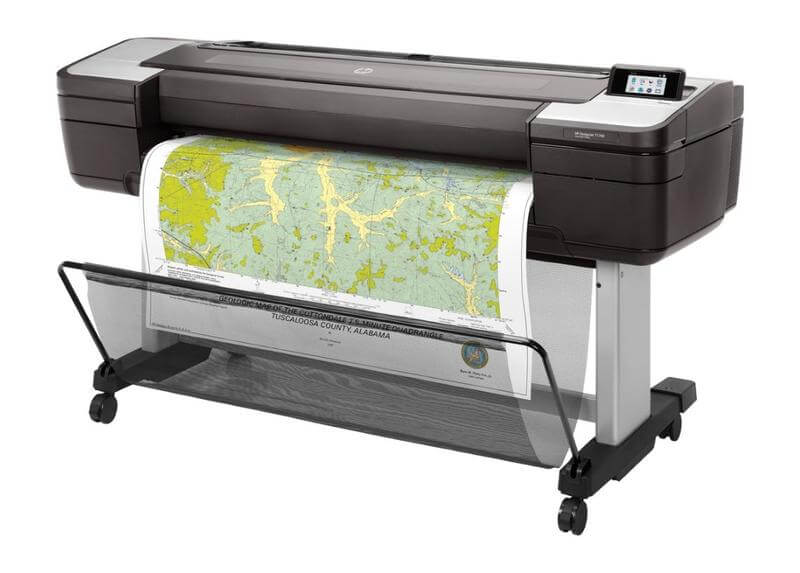
In engineering projects, plotters are widely used. Because they have the ability to draw continuous lines, whereas ordinary printers use closely spaced dots to conventionally drew lines. Plotters are designed in different forms, and they use different-different tools to draw lines on the paper. For example, a 3-D plotter (cutting plotter) uses knives to design any type of diagram or cut out a piece of material on the basis of given inputs from the computer. On the other hand, most of the plotters use a pen to draw lines on the paper. The object that is to be cut is located on the flat surface in front of the plotter. The computer forwards cutting design and dimensions to the plotter for producing an exactly carved design. Then, repeat the cutting process on hundreds of objects to produce identical copies of the same designs. Applications of Plotters
How does plotter work?A plotter works in tandem with imaging software on a computer to create a finished image or object. In using a plotter, the first step is to enter the suitable coordinates to display the pictures on the paper. Drawing lines and images with imaging software is a simple way to achieve this goal with modern software. When the schematics for the image are finished, the computer sends the coordinates to the plotter. The computer then decodes the code and calculates the best way to use the pen and paper. HPGL2 and DMPL are two programming languages used by later plotters from Hewlett-Packard and Houston Instruments, respectively. Initially, plotters had two separate pens, one moved horizontally, and one moved vertically. These plotters were limited in terms of image complexity because they produced outputs at a slow rate. Modern plotters employ a sliding roller to move the paper against a stationary pen. Plotter pens are usually hollow fibre rods with a sharpened end. Until the drawing is finished, the ink supply flows and dispenses through the sharpened tip through the centre of the rod; the paper travels vertically and horizontally against the pen. Types of plotterThere are various types of a plotter, which are as follows: Drum PlottersDifferent sorts of printer designs that draw on paper that is wound around a drum are referred to as "drum printers." The plot is produced in one direction by the drum, while the other is produced by the pens moving in the opposite way. Because it included printed characters carved on a physical drum and impacted paper in certain ways, the previous iteration of the printer is today referred to as a drum plotter. The drum plotter utilises a drum to move the paper left and right while one or more pens write up and down, according to the Chron website. The plotter's ability to draw in numerous colours is enhanced by the use of multiple pens. 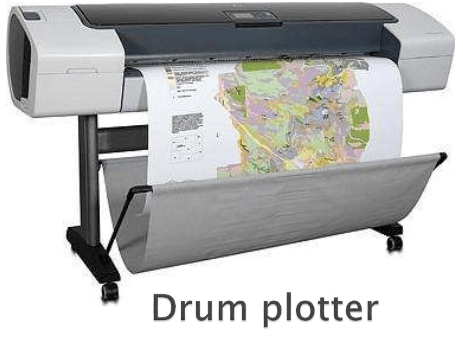
Flatbed plottersA flatbed plotter works with paper that is put on a flat surface in a stationary position. In this plotter, the writing pen moves in both the x and y axes. Flatbed plotter pens are available in a number of sizes and colours. Unlike a drum plotter, it works by moving a pen over paper rather than a paper beneath the arm. The paper's size is governed by the size of the flat surface on which it is placed. Larger flatbed plotters have the ability to print up to 60-inches in length on the paper. 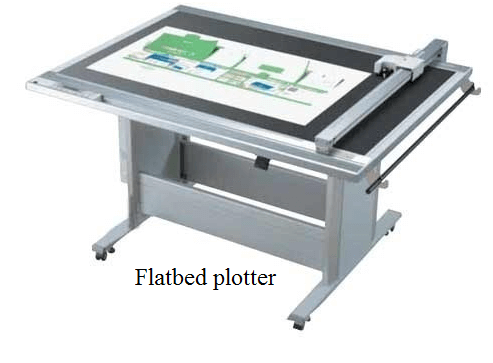
In addition to printing on paper, some flatbed plotters are able to print on other materials such as plastic, cardboard, or even metal. Flatbed plotters can make exact copies again and over again without sacrificing the quality of the printed drawing. However, they can be rather expensive to buy and fairly huge in size. An early flatbed plotter, the CalComp Model 738, is an example. It had a big bed on which large designs could be made, and it was employed in the 1970s. This plotter also used a magnetic tape to input data because it was an offline flatbed plotter. Cutting PlotterThe cutting plotter is a large-scale cutting machine that uses blades instead of pens to cut the design. It creates mylar or vinyl lettering and graphics that are pre-cut. The plotter's flat surface is used to place the to-be-cut paper. The plotter receives a command from the computer, and the knife executes it to cut the media to the appropriate dimensions. 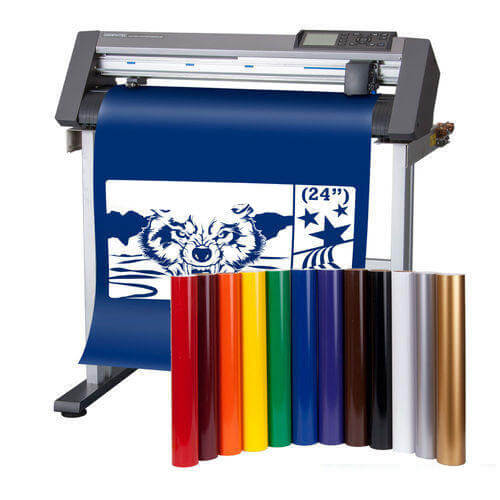
Inkjet PlotterThe inkjet plotter, as the name implies, sprays microscopic droplets of ink onto paper to form an image, text, or pattern. Inkjet plotters are a popular choice for graphic designers and advertising agencies; they are commonly used for a large printer, like billboards, banners, and big signs that are used for roadside indication. Thermal and piezo-electric are both technologies that are used by inkjet plotters. Ink droplets are applied using heat in thermal inkjet plotters, whereas charged crystals are used in piezoelectric plotters. On average, inkjet printers generate higher-quality graphics than other plotters. 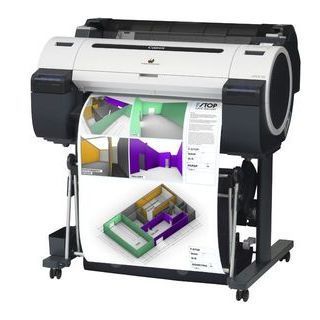
Electrostatic PlottersIn electrostatic plotters, the images are produced on paper by using raster graphics rather than vector graphics. By using toner ink, dot matrix pixels are generated on the paper. The high voltage charges are created on the paper by the plotter, and these charges hit the toner ink for drawing computer-aided designs. The electrostatic plotters are much faster and economical in price, but they produce lower quality than pen-plotters. 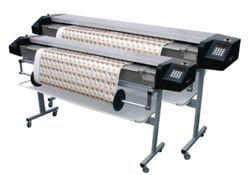
History of plotterThe first plotter was created by Remington-Rand in 1953. It was used in combination with the UNIVAC computer to make technical drawings. A number of printer control languages have been developed to run pen plotters. Also, transmitted commands such as place pen on paper, lift the pen from the paper, or draw the line here to here. Hewlett-Packard's HP-GL, HP-GL/2, and Houston Instruments DMPL is common ASCII-based plotter control languages. Below is given an HP-GL script to draw a line: 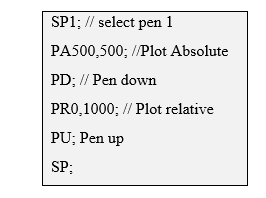
In the late 1960s and 1970s, Tektronix and Hewlett Packard produced small, desktop-sized flatbed plotters. The pens were arranged on a moving bar, with the y-axis reflecting the bar's length and the x-axis representing the bar's movement across the plotting table. These plotters were sluggish to operate because to the weight of the bar. In the 1980s, a compact and lightweight HP 7470 introduced the "grit wheel" mechanism, which, unlike the Calcomp plotters two decades before, eliminated the requirement for perforations around the edges. The grit wheels press on the sheet's durable polyurethane-coated rollers at opposite edges, creating microscopic indentations. Because the grit particles fall into the previous indentations, the grit wheels keep the sheet in good register while it is pushed back and forth. The pen goes back and forth in a line between the grit wheels as it is mounted on a carriage to represent the orthogonal axis. For the HP 2647, which was the precursor of the current Powerpoint chart and used the plotter to draw huge letters on transparency, Hewlett Packard's MultiPlot developed the single category, "word chart." Pen plotters, affordable memory, and computers fast enough to rasterize colour images have all departed with the widespread availability of high-resolution inkjet and laser printers. However, inkjet-based, large-format engineering plotters still have the grit wheel mechanism. Furthermore, in the greeting card area of supermarkets, plotters were also used in the Create-A-Card kiosks that used the HP 7475 six-pen plotter. Mainly, plotters are used in CAD and technical drawing applications, as they provide the benefit of working on very large paper sizes, including high resolution. It is also found in many garment and sign shops as it's another use has been found by replacing the pen with a cutter. The plotter involves altering the colour or width of a line to change the pens. On tiny plotters, this was done manually. Also, some of the plotters can be done automatically, as they have automatically organized a magazine of four or more pens. Instead of page printing speed, the speed of pen plotters can be measured by acceleration rate and pen speed. Because the type of pen used limits the speed of a pen plotter, the pen used is the most significant component. Although most modern pen plotters feature slewing speed control instructions, these commands differ depending on the type of pen in use. There are different kinds of pen plotters, but some of them are no more produced on a large scale. Often, technical pen tips are used; many of them can be renewed with the help of supplies and parts for manual drafting pens. Early grit wheel and HP flatbed plotters used small plastic nib disposable or proprietary fiber-tipped pens. A plotter pen uses a cellulose fibre rod that is put into a foam tube soaked with ink, via which the rod's end is sharpened into a conical tip. Capillary wicking takes ink from the foam down the rod as the pen travels across the paper. The migration of ink to the tip slows down as the ink supply in the foam is reduced. As the charting speed slows, a worn-out pen is used to draw the line to keep it dark. But until the foam is completely depleted, the fading will continue. Furthermore, as the fibre tip pen is used, the tip gradually wears away on the potting medium, resulting in a broader, smeared line. They are generally more expensive and uncommon, and they do not fade or wear like fibre pens. Furthermore, standard ball-point pens can be converted to function with most pen plotters. Advantages of plotter
Disadvantages of plotters
Vinyl cutterA vinyl cutter is a machine that cuts vinyl into various forms for T-shirt logos, posters, signs, billboards, and other materials. It is a little device that may be plugged into a computer via a cable. It's about the same size as a computer printer. This machine is mostly controlled by a computer, which guarantees that the Vinyl machine's sharp blades move appropriately. 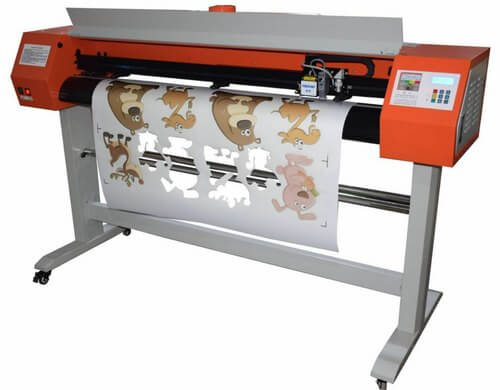
The function of sharp blades is to cut the letters or several shapes from sheets of the glue Vinyl material. They can be stuck on any surface you may like when these letters or shapes are cut with the vinyl machine. Like the movements of a Vinyl cutter machine are controlled by the computer, so while the Vinyl machine is cutting any design of your choice, its blade can be moved from the X-axis to the Y-axis of the material. If you want to create a specific shape or symbol that you can paste anywhere, the Vinyl cutter is the best machine to complete these types of tasks. |
 For Videos Join Our Youtube Channel: Join Now
For Videos Join Our Youtube Channel: Join Now
Feedback
- Send your Feedback to [email protected]
Help Others, Please Share










